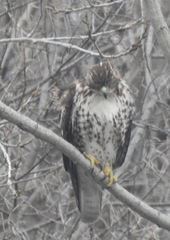Red-tailed Hawk
Common Name: Red-tailed Hawk.
Scientific Name: Buteo Jamaicensis.
What to look for? These beautiful birds are North America's most common hawks. The silhouette of the Red-tailed hawk highlights its broad, round-tipped wings. Its signature red tail is most noticeable from above. From a view below, it is mostly pale with a darker belly band, wing tips, and edges of the flight feathers. The head of the Red-tailed Hawk is brown with a white throat.
Where can they be found at Carillon Stonegate Pond? Red-tailed Hawks are around here all year. Look in the skies over the fields and woods north of our ponds and you will see them soaring above. They also like to perch in the trees just north of our ponds and occasionally will swoop into one of the trees in our yards.
How big are they? The Red-tailed Hawk averages 20 inches in length. And their wingspan is a broad four feet. Although they are one of the largest birds you’ll see in North America, they weigh in at only around 2 ½ pounds.
What are their flight patterns? Red-tailed Hawks fly by "Flap-gliding" where short periods of flapping are alternated with intervals in which the wings are extended in a glide and by "Soaring" when winds or updrafts exist. Red-tailed Hawks will soar magnificently in the skies above open fields, slowly turning wide circles on their broad, rounded wings. When flapping, their wingbeats are heavy. In high winds or on thermal updrafts, Red-tailed Hawks may hover or glide for long periods of time.
How else do they behave? They are keen-eyed and efficient hunters. Although Red-tailed Hawks are commonly seen soaring, they are primarily perch-hunters. They perch on tree limbs, telephone poles, or other high structures to look for prey. When they detect prey on the ground, they glide downward, pushing their legs forward when nearing the prey and impaling it with their talons. They may also hunt as a pair, guarding opposite sides of the same tree, for example, to catch tree squirrels.
What’s for dinner? Rodents and other mammals! Red-tailed Hawk is a carnivore! They feast primarily on mammals including voles, mice, wood rats, rabbits, snowshoe hares, jackrabbits, and ground squirrels.
Where do they take up residence? They are found all over the continent, in Central America, and in the West Indies. Red-tailed Hawks occupy just about every type of open habitat on the continent.
When and where do they breed and nest? Red-tailed Hawks are monogamous and often remain paired throughout the year. Nesting takes place from February through May. At the beginning of the breeding season, they perform impressive aerial courtship flights, accompanied by shrill screams. The nest is built in a tall tree, often the tallest tree in a cluster, or on cliff ledges, towers, nest platforms, and occasionally buildings.
Where do they migrate? Most Red-tailed Hawks residing in Alaska, Canada, and the northern Great Plains will fly south for a few months in winter (sound familiar?). Red-tailed Hawks from across the rest of the North America typically stay put and do not migrate.
What is their conservation status? There is low concern. According to the North American Breeding Bird Survey, the Red-tailed Hawk has seen increases in populations. Partners in Flight estimates the global breeding population at 3.1 million.
Do they make any interesting sounds? The Red-tailed Hawk has a thrilling, raspy scream that sounds – well, exactly like a raptor should sound! Here is a link to the sounds of the Red-tailed Hawk.
Interesting Facts About the Red-tailed Hawk:
-
Red tailed hawks have excellent vision - which is 8 times more powerful than the eyesight of a human - and see in color.
-
The red tailed hawk population is estimated to be over 1 million in the United States
-
Red tailed hawks are the most commonly used bird in falconry.
-
Whenever a hawk or eagle appears onscreen – television or movie, no matter what species, the shrill cry on the soundtrack is almost always a Red-tailed Hawk.
-
There is a bony ridge over the eye socket that provides shade for the eyes in direct sunlight - the way a baseball cap provides shade for our eyes.
-
The Red-tailed Hawk’s curved beak and sharp talons help it to efficiently catch its prey.
-
The oldest known wild Red-tailed Hawk was at least 30 years.
For more information on Red-tailed Hawk and sources of information used in this blog (these are the sources that I am using to learn as I blog), please visit All About Birds and the Audubon Society. And the Cornell Lab of Ornithology provides a wonderful source of information for anyone interested in learning more about birds.
The Carillon at Stonegate community is very fortunate to have a variety of wetland, forest and prairie environments conducive to a variety of birds and other wildlife, plants and insects. Our community and the Kane County Forest Preserve do an exceptional job in maintaining this natural environment – both for the benefit of the birds and wildlife and for our residents to enjoy.
Take a hike and see what you can find – and identify!























